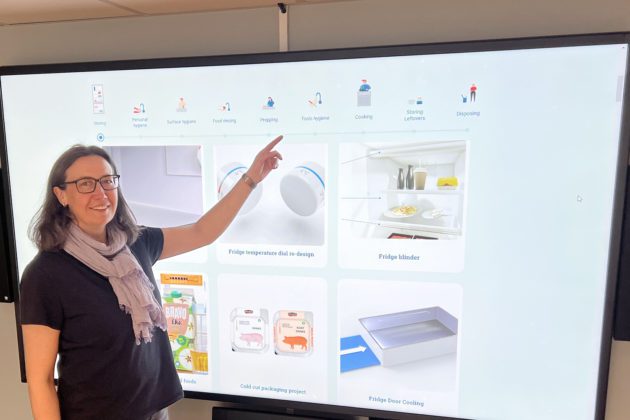Free ideas for new products that keep people healthy

Do you want to create and sell something completely new, and at the same time help keep people healthy? The EU project SafeConsume and Senior Scientist Antje Gonera in Nofima has nearly 80 new product ideas ready – and free of charge for anyone who wants to turn some of them into viable products.
A temperature gauge for the refrigerator and a drying rack for dishcloths; a cutting board that changes colour; a cooling box for food leftovers. Most cases of food poisoning originate at home in the kitchen. The product ideas developed by Gonera and her colleagues at Nofima, AHO and Designit can help prevent several of them.
A book of ideas
Behind all of this is the EU-funded research project SafeConsume, where scientists and industry players across Europe collaborated to find solutions to help people improve their kitchen practices at home and develop products, so they don’t get sick from what they eat. Nofima coordinated the entire project.
After five years, the project concluded last year, having provided a lot of insights and several ideas for new products. However, the work has only just begun. Antje Gonera now has a list of tools and products that have been developed to some extent – representing good ideas that nobody has yet had the opportunity to put into production and introduce to the market.
“It’s unusual for us to do something like this in connection with a research project. Towards the end of the project, we created a ‘book of ideas’ containing more than 75 prototypes and concepts which we are going to release to the public in the hope that someone out there wants to do something with them”, she says.
Ikea and design students
Large corporations such as Ikea and Unilever have been involved in the process, and so have technology entrepreneurs such as Keep-It and C-Tech, design students at AHO and design professionals at the Oslo based company Designit. “Some of the ideas have been developed further by them, but we are still left with many ideas that our partners could not do anything with”, says Gonera.
The scientists have observed food and consumers all the way from the store to the kitchen, and looked at everything that happens there. They have seen where the bacteria come into play, and what needs to be done to stop them: storage in the refrigerator or freezer; routines for washing hands, the counter, the food and the cooking utensils; how you prepare the food, and how you store and discard the leftovers.
Keeping the fridge cool enough
Personally, Antje Gonera really likes the proposed solution for better temperature control in the refrigerator: A dial that doesn’t show a scale from 1 to 5, but rather shows the actual temperature, so you can set the target temperature. In many places, food is stored in refrigerators that are not cold enough. This idea is both easy to use and solves an important issue considering foodborne illnesses.
Another idea which the Senior Scientist highlights, is better packaging for cold cuts and spreads. “Many people bring these products in and out of the refrigerator – often leaving them on the table for long periods of time when you enjoy those long, lazy breakfasts. When that happens, the bacteria are allowed to grow so that the products go bad long before the ‘due by’ date on the package”, she says.
In response, one of the AHO students has developed new packaging containing a material that changes colour when the product gets too warm. “When you leave the packet on the table for too long, it turns red – as a visual signal that it’s time to put that ham back in the fridge”, she says. Using a pack of ham as an example, the design students suggested using an image of a pig that changes colour.
Cutting boards with a bacterial warning
“Another thing that can change colour is the chopping board which you use to cut chicken. When it comes into contact with raw chicken, it changes colour as a visual reminder that you need to clean it”, says Gonera.
The dishcloth is one of the worst culprits in the kitchen. In several countries it is also customary to use a sponge or cloth to wash dishes – the dish brush is not as universal as we might think. Some of the ideas for novel products involve making sponges that will not be left by the sink all crushed up, as well as new ways to dry your dishcloth.
“It is important that we can be this specific in a research project. The inventions we have come up with are not just fancy objects with stylish designs. These are ideas that have emerged through empirical research into the problem areas we have identified”, says Antje Gonera.
Facts about the research and the project
The research project SafeConsume (Grant agreement EU727580) was funded by the EU and had 32 partners from 14 European countries, with Nofima at Ås being in charge of the project.
In Norway, Keep-It Technologies, OsloMet, the Oslo School of Architecture and Design and Designit Oslo were also involved. There were also three groups with operations in Norway: Ikea, Unilever and Arçelik (the owner of Grundig). The list of all ideas that are free to use can be found at safeconsume.eu/book-of-ideas

